How Can You Not Love These People! …
… even though “My [insert the item of your choice] Doesn’t Work”From David: It’s now three weeks since we left India for Sri Lanka (and now we’re back momentarily to catch our final flight home) and it makes me think once again about one of the big reasons we keep coming back to India. It is impossible to be in the country without interacting personally with the people you encounter on the street or in the shops. At the risk of stereotyping, the personality of the place just doesn’t permit it. Sometimes it can be infuriating, as when some guy walks up to you on the street and asks, “Will you please talk with me because I need to practice my English” and, by the way, “I have a brother who sells [whatever you can be persuaded to buy]. Let me show you his shop”, and he follows you for a hundred yards down the street repeating this mantra. But most times the unavoidable interaction is a pleasure.An example of the latter. I was traveling with Sam in Jodhpur, one of the big cities in Rajasthan, and he went out to wander by himself the last day before he flew home. When we caught up with each other that evening, he told me he had discovered a stall that sold the best samosas in the world. It was in the street market just beyond the clock tower. I found the place the next day and went to buy one. It was an open air stall with a huge cauldron of canola oil heated by a 787 Dreamliner jet engine, filled with the promised “best in the world” samosas.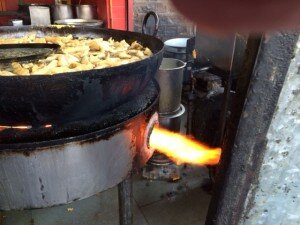 Locals on their lunch-break surrounded the place 10-deep. I seemed to be the only tourist in the crowd, and when I finally pushed my way to the counter to buy one (pushing was the only way I could reach the counter), the man behind the counter said “No! Not for you!”I persisted and pressed my 10 rupees (15¢) across the counter. “No! Not for you!” I persisted again and again, and again and again it was, “No! Not for you!” A few minutes later, the man removed a fresh batch of samosas from the kettle, wrapped one in a piece of newspaper, and handed it to me with a warm smile. “Hot one for you!” I joined the 30 or 40 people sitting on the sidewalk and street pavement around the stall, surrounded by littered newspaper pages saturated with canola oil, and enjoyed the best hot samosa in the world.A second example. Sam and I were having a beer outside a food stand in a Jodhpur park. Three young Indian men, in their late teens or early 20s, walked over and asked if they could have their picture taken with us. We were willing, and that started a photo shoot in which each of them wanted a photo of us with him alone. Since each wanted his shot taken on multiple cellphone cameras, it was a while before Sam and I could resume enjoyment of our beers. Ten minutes later the three young men reappeared with ice cream cones they had just bought in the food stand, and handed the cones to Sam and me. “Thank you for letting us have our photographs with you.”A third example. I developed a bronchial cough from the air pollution in the city of Ahmedabad and stepped into a pharmacy – actually a 10 foot-wide street stall filled with shelves bearing boxes of pills, creams, syrups and every other type of medication. I told the man my symptoms and he gave me a cough suppressant, an inhaler and some pills that said they were “Type H” medications that could be dispensed only with a doctor’s prescription. I paid my 150 rupees ($2.50) and he stepped back behind the overloaded shelves, returning after a moment with a hot cup of masala tea that he handed to me. “You are a good customer and sick. This will make your throat feel better.”And yet another example. I wrote in an earlier post about my visit to the wonderful Jain temple complex at the Rajasthan hill station of Mt. Abu. I was wandering slowly around the temples when a handsome young boy tapped my hand. He was around 8 years old, dressed in a pressed white shirt, white shorts, white socks and polished black shoes, with his hair neatly combed. “Can I show you the temple, please?” I spent the next 20 minutes being led by him around the temple, getting an explanation at every turn. My tour ended only when his father found us and said it time for him to go home. When I thanked him, he answered, “Thank you for letting me show you.”As I mentioned at the outset, however, there are infuriating experiences as well. One occurred in Goa when we wanted to hire a car and driver to take us from north part of the state where we were staying to a museum in the south. We started out at 8 am, when the temperature was still moderate and we drove with the windows open. By 8:30, when the temperature was reaching the mid-80s, I asked the driver to turn on the AC. “AC is broken.” I tried to stay cool the rest of the way by keeping the window open so a 90° wind could blow in my face. When we got back into the car after visiting the museum something made me ask him again to try the AC. “AC is broken.” I asked again, “Please just try it. Maybe driving over the bumps has jiggled something back into place.” After a few more repetitions of this exchange, he explained that he could not “just try it” because his mechanic had told him that “just trying AC would break the car.” After a few repetitions of this new, expanded dialog he added, “The part won’t be in until tomorrow.” This exchange went on for almost 15 minutes in the museum parking lot, inside the car where the temperature was certainly in the mid-90s. When the driver finally realized I wasn’t going to relent, he “just tried” to turn on the AC, and it worked fine. All I could figure was he was simply trying to save 50¢ by not using the AC.And then there was the hotel where we had prawns for dinner. They were Rs. 600 on the menu, but were Rs. 800 on the bill presented to us when checking out the next morning. I pointed out the discrepancy and the clerk apologized and corrected the mistake. Then I noticed that our soup was Rs. 270 on the bill but had been only Rs. 170 on the menu. When I questioned that item as well, the clerk decided to correct all the items on the bill and the total amount dropped from Rs. 3,850 to Rs. 2,530. Then the manager came over and, unlike the clerk who had apologized for “our mistake,” he insisted that the original bill had been correct because of taxes, and that I must pay the full amount. I asked how the tax could be 33% on the prawns, 58% on the soup, and 52% on the overall amount. He snarled that I could pay the reduced amount. However, when I handed him my credit card, he said his card reader was broken and that I had to pay in cash. The card reader really wasn’t broken, but we were already late and I wanted to avoid another standoff of “just try it.” So when he said he would accept dollars or rupees I pulled out a US $100 bill and asked for change, either in dollars or rupees. He refused the offer even though he had just said he was happy to be paid in dollars. I repeated the offer three more times while the clerk whispered to Lora that the manager was crazy. After the third repetition the manager told us to get out of the hotel. So we backed out the door, with me offering the credit card in one hand and the $100 bill in the other. He refused both even as we got into the car and drove off. It was a fine hotel and restaurant that I’m sure you’d enjoy. Ask me for the name if you’re sharp-eyed when paying your bill and have endurance with crazy managers.We had another credit card incident in Hyderabad when paying for our apartment. The rental company sent someone with a credit card reader over to the apartment the morning of our departure to process the payment. The charge was Rs. 7,200 ($115, for 4 nights) but when I started to sign the slip I saw that the person had processed the payment for Rs. 70,200 ($1,135). Unfortunately, "Sir, I am sorry but we are not able to process credits with this card reader, only charges." I won't bore you with the details of the conversation that ensued as we ran out the door to catch our flight, but the money ended up in our account, not the rental company's.Lora just looked this posting and says that there are not enough photographs for the length of the text. So here are some more photos. They were all taken in Sri Lanka and have nothing to do with the posting, but I’m not sure that’s relevant.
Locals on their lunch-break surrounded the place 10-deep. I seemed to be the only tourist in the crowd, and when I finally pushed my way to the counter to buy one (pushing was the only way I could reach the counter), the man behind the counter said “No! Not for you!”I persisted and pressed my 10 rupees (15¢) across the counter. “No! Not for you!” I persisted again and again, and again and again it was, “No! Not for you!” A few minutes later, the man removed a fresh batch of samosas from the kettle, wrapped one in a piece of newspaper, and handed it to me with a warm smile. “Hot one for you!” I joined the 30 or 40 people sitting on the sidewalk and street pavement around the stall, surrounded by littered newspaper pages saturated with canola oil, and enjoyed the best hot samosa in the world.A second example. Sam and I were having a beer outside a food stand in a Jodhpur park. Three young Indian men, in their late teens or early 20s, walked over and asked if they could have their picture taken with us. We were willing, and that started a photo shoot in which each of them wanted a photo of us with him alone. Since each wanted his shot taken on multiple cellphone cameras, it was a while before Sam and I could resume enjoyment of our beers. Ten minutes later the three young men reappeared with ice cream cones they had just bought in the food stand, and handed the cones to Sam and me. “Thank you for letting us have our photographs with you.”A third example. I developed a bronchial cough from the air pollution in the city of Ahmedabad and stepped into a pharmacy – actually a 10 foot-wide street stall filled with shelves bearing boxes of pills, creams, syrups and every other type of medication. I told the man my symptoms and he gave me a cough suppressant, an inhaler and some pills that said they were “Type H” medications that could be dispensed only with a doctor’s prescription. I paid my 150 rupees ($2.50) and he stepped back behind the overloaded shelves, returning after a moment with a hot cup of masala tea that he handed to me. “You are a good customer and sick. This will make your throat feel better.”And yet another example. I wrote in an earlier post about my visit to the wonderful Jain temple complex at the Rajasthan hill station of Mt. Abu. I was wandering slowly around the temples when a handsome young boy tapped my hand. He was around 8 years old, dressed in a pressed white shirt, white shorts, white socks and polished black shoes, with his hair neatly combed. “Can I show you the temple, please?” I spent the next 20 minutes being led by him around the temple, getting an explanation at every turn. My tour ended only when his father found us and said it time for him to go home. When I thanked him, he answered, “Thank you for letting me show you.”As I mentioned at the outset, however, there are infuriating experiences as well. One occurred in Goa when we wanted to hire a car and driver to take us from north part of the state where we were staying to a museum in the south. We started out at 8 am, when the temperature was still moderate and we drove with the windows open. By 8:30, when the temperature was reaching the mid-80s, I asked the driver to turn on the AC. “AC is broken.” I tried to stay cool the rest of the way by keeping the window open so a 90° wind could blow in my face. When we got back into the car after visiting the museum something made me ask him again to try the AC. “AC is broken.” I asked again, “Please just try it. Maybe driving over the bumps has jiggled something back into place.” After a few more repetitions of this exchange, he explained that he could not “just try it” because his mechanic had told him that “just trying AC would break the car.” After a few repetitions of this new, expanded dialog he added, “The part won’t be in until tomorrow.” This exchange went on for almost 15 minutes in the museum parking lot, inside the car where the temperature was certainly in the mid-90s. When the driver finally realized I wasn’t going to relent, he “just tried” to turn on the AC, and it worked fine. All I could figure was he was simply trying to save 50¢ by not using the AC.And then there was the hotel where we had prawns for dinner. They were Rs. 600 on the menu, but were Rs. 800 on the bill presented to us when checking out the next morning. I pointed out the discrepancy and the clerk apologized and corrected the mistake. Then I noticed that our soup was Rs. 270 on the bill but had been only Rs. 170 on the menu. When I questioned that item as well, the clerk decided to correct all the items on the bill and the total amount dropped from Rs. 3,850 to Rs. 2,530. Then the manager came over and, unlike the clerk who had apologized for “our mistake,” he insisted that the original bill had been correct because of taxes, and that I must pay the full amount. I asked how the tax could be 33% on the prawns, 58% on the soup, and 52% on the overall amount. He snarled that I could pay the reduced amount. However, when I handed him my credit card, he said his card reader was broken and that I had to pay in cash. The card reader really wasn’t broken, but we were already late and I wanted to avoid another standoff of “just try it.” So when he said he would accept dollars or rupees I pulled out a US $100 bill and asked for change, either in dollars or rupees. He refused the offer even though he had just said he was happy to be paid in dollars. I repeated the offer three more times while the clerk whispered to Lora that the manager was crazy. After the third repetition the manager told us to get out of the hotel. So we backed out the door, with me offering the credit card in one hand and the $100 bill in the other. He refused both even as we got into the car and drove off. It was a fine hotel and restaurant that I’m sure you’d enjoy. Ask me for the name if you’re sharp-eyed when paying your bill and have endurance with crazy managers.We had another credit card incident in Hyderabad when paying for our apartment. The rental company sent someone with a credit card reader over to the apartment the morning of our departure to process the payment. The charge was Rs. 7,200 ($115, for 4 nights) but when I started to sign the slip I saw that the person had processed the payment for Rs. 70,200 ($1,135). Unfortunately, "Sir, I am sorry but we are not able to process credits with this card reader, only charges." I won't bore you with the details of the conversation that ensued as we ran out the door to catch our flight, but the money ended up in our account, not the rental company's.Lora just looked this posting and says that there are not enough photographs for the length of the text. So here are some more photos. They were all taken in Sri Lanka and have nothing to do with the posting, but I’m not sure that’s relevant.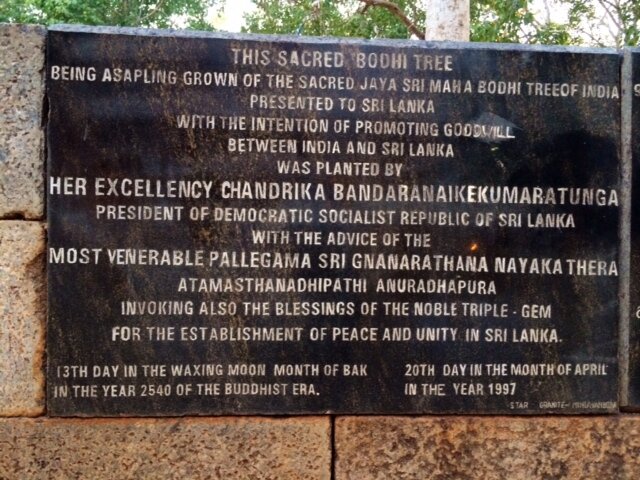 The above plaque is next to a holy Bodhi tree in Anuradhapura, Sri Lanka, said to be grown from a cutting of the tree under which Buddha received enlightenment. It illustrates one of the difficulties I encountered in Sri Lanka – there are two many syllables in most names for me to handle. As with the name of the President of Sri Lanka, whose last name (spelled out in the plaque) has 23 letters. Or the towns of Tissamaharama and Atamasthanadhipathi Anuradhapura. These are not names that come skipping off my tongue.
The above plaque is next to a holy Bodhi tree in Anuradhapura, Sri Lanka, said to be grown from a cutting of the tree under which Buddha received enlightenment. It illustrates one of the difficulties I encountered in Sri Lanka – there are two many syllables in most names for me to handle. As with the name of the President of Sri Lanka, whose last name (spelled out in the plaque) has 23 letters. Or the towns of Tissamaharama and Atamasthanadhipathi Anuradhapura. These are not names that come skipping off my tongue.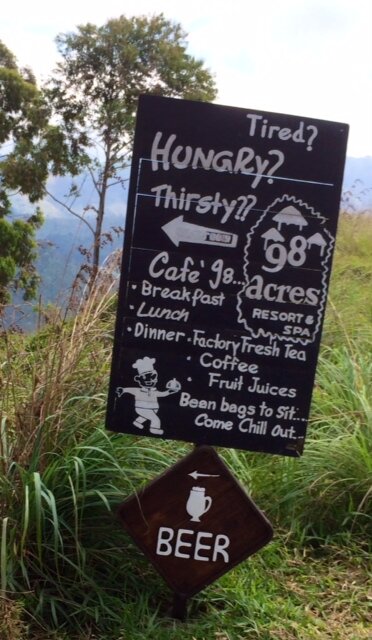 This sign greets you after a hard climb to the top of Little Adam’s Peak (actually not so little) in the Sri Lanka town of Ella. The 98 Acres Resort that was trying to get our business was back at the base of the peak, so the sign is really just a tease. But it’s a very high-end tease; 98 Acres is a beautiful set of 10 bungalows where we tried to stay. Unfortunately, we were number 11.
This sign greets you after a hard climb to the top of Little Adam’s Peak (actually not so little) in the Sri Lanka town of Ella. The 98 Acres Resort that was trying to get our business was back at the base of the peak, so the sign is really just a tease. But it’s a very high-end tease; 98 Acres is a beautiful set of 10 bungalows where we tried to stay. Unfortunately, we were number 11.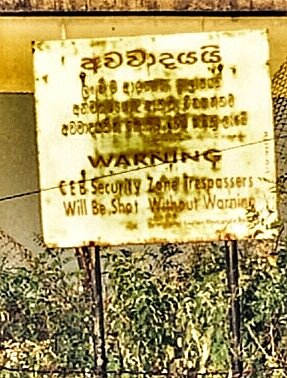 Here is another Sri Lanka sign, but it is definitely not in the "tease" category. It’s at a reservoir water treatment plant next to the Bundala National Park, a fabulous bird sanctuary. In case you can’t make out the writing, it says: “WARNING. CEB Security Zone. Trespassers Will Be Shot Without Warning.”
Here is another Sri Lanka sign, but it is definitely not in the "tease" category. It’s at a reservoir water treatment plant next to the Bundala National Park, a fabulous bird sanctuary. In case you can’t make out the writing, it says: “WARNING. CEB Security Zone. Trespassers Will Be Shot Without Warning.”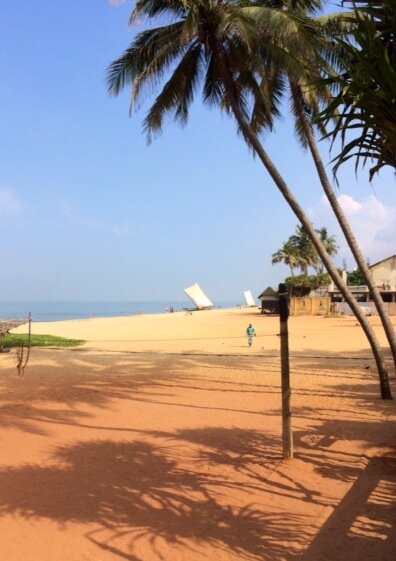 This was the beach outside our bungalow door at the Ice Bear Guest House in Negombo, Sri Lanka. The name of the place is a little strange, but it doesn’t get any better than this.
This was the beach outside our bungalow door at the Ice Bear Guest House in Negombo, Sri Lanka. The name of the place is a little strange, but it doesn’t get any better than this.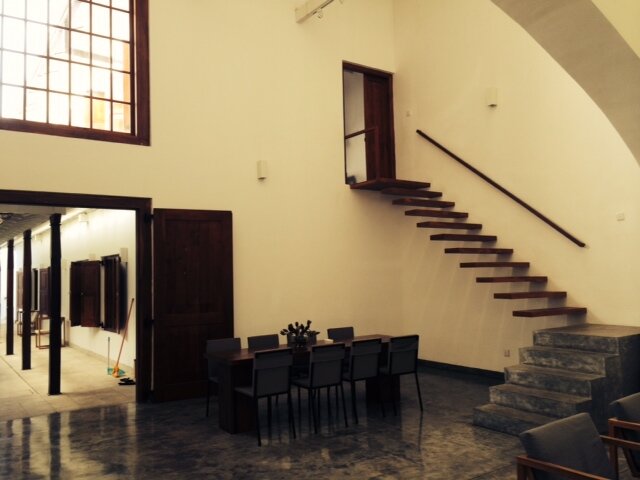 I'm including this photo because I love the design of the building code-violating staircase. Galle is a town on a peninsula at the southwestern tip of Sri Lanka, about 400 miles north of the equator. The Portuguese settled the peninsula in the 16th century and the Dutch fortified it in the 17th century. We stayed at the Fort Printers Hotel (shown in this photo), an old Dutch mansion that had been used a few hundred years ago for a printing business. It was in all respects – building, staff, food, etc. -- the best of the hotels we encountered in our 2 months here and in India. Because the Fort is a UNESCO World Heritage Site the exterior of the building remains as it was during its printing days. However, as you can see, the hotel has done a beautiful job of creating an elegant contemporary interior at harmony with the 400-year old exterior.I think these are enough photos to satisfy Lora.
I'm including this photo because I love the design of the building code-violating staircase. Galle is a town on a peninsula at the southwestern tip of Sri Lanka, about 400 miles north of the equator. The Portuguese settled the peninsula in the 16th century and the Dutch fortified it in the 17th century. We stayed at the Fort Printers Hotel (shown in this photo), an old Dutch mansion that had been used a few hundred years ago for a printing business. It was in all respects – building, staff, food, etc. -- the best of the hotels we encountered in our 2 months here and in India. Because the Fort is a UNESCO World Heritage Site the exterior of the building remains as it was during its printing days. However, as you can see, the hotel has done a beautiful job of creating an elegant contemporary interior at harmony with the 400-year old exterior.I think these are enough photos to satisfy Lora.
